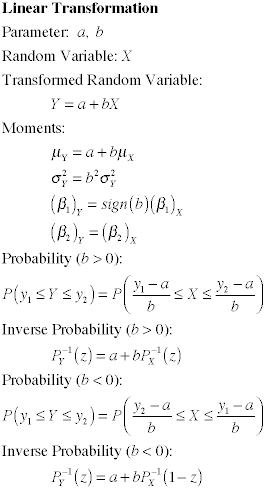 |

|
Named distributions
are defined over specific ranges of the random variable. For
examples, the binomial distribution is defined on the nonnegative
integers, the exponential distribution is defined over the
nonegative real numbers and the Beta distribution is defined
on the range [0, 1]. In applications, it is often useful to
make linear transformations of
random
variables that are controllable though parameters on the worksheet.
This shifts the mean, changes the variance and may change
the sign of the skewness. Formulas for probabilities and inverse
probabilities are also adjusted. When the Linear
Transform button
on the distribution dialog is checked, two additional parameters,
a and b are included on the form. The add-in
user-defined functions use the transformation parameters to
adjust the moments, probabilities and inverse probabilities
as shown
to
the left.
The example below shows three distributions all based on the
same Beta distribution. The first case
makes no transformation because a is 0 and b is
1. The second case multiplies the random variable by 2 and
adds 2 to the result. The distribution is shifted and spread
out. The mean and variance change, but the skewness and kurtosis
remain the same. The third case multiplies the random variable
by -1. This flips the distribution to the range [-1,0]. The
mean changes in sign, the variance remains the same and the
skewness changes sign. The kurtosis is not affected by a transformation.
The ranges of probability statements and the values of inverse
probabilities are changed by the transformation. |



